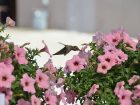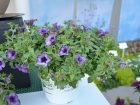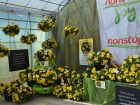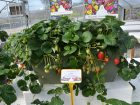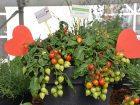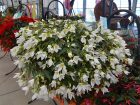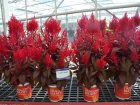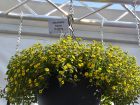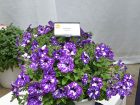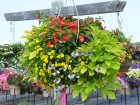
Features
Crops
Flowers
Time to Trial – Next Year’s Market Winners
Increasing plant sales is best done by helping the consumer be successful … trial new varieties at your own facility so you know how to grow them, track consumer appeal and monitor their garden performance.
June 9, 2015 By Melhem Sawaya
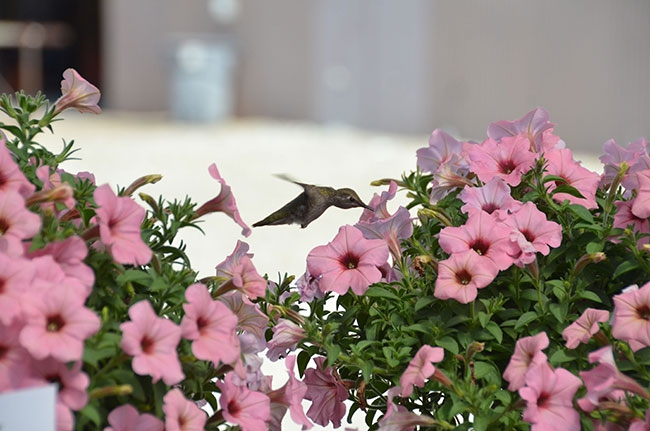
The California Spring Trials, (what I call the California Showcase) is very interesting in the sense that you feel it is something you must attend. After the tour, you have a sense of “variety overload” with all the excitement in wanting to trial many of the varieties you saw.
It’s when you get home and start reviewing the pictures and analyzing the entire trip that you end up trying only two or three varieties, which is the right thing to do. Try them in limited quantities until you know the most effective growing practices and can gauge consumer response and garden performance in your area.
If you are visiting the trials for the first time, or perhaps you skipped two years, then yes, you will still learn something new. The great benefit from visiting the showcase is the opportunity to meet the people you usually talk to over the phone or via e-mail with questions about a variety or a production question. Communicating with them face-to-face will always be better, no matter how advanced the new communication technologies get.
NETWORKING OPPORTUNITIES
Networking involves face-to-face communication – it’s not something you can do on the Internet. New technologies are great for communicating details and transactions, but you never really get to know people (customers and/or suppliers) to build lasting business relationships.
From my perspective, less than 25 per cent of the California Showcase participants are growers. The event is geared to buyers and, specifically, to brokers or chain buyers. That’s probably why the “trials” aspect disappeared. As for growers, many can’t find anything new to learn at the Spring Trials, apart from new colours and new cultivars that have not yet been tested. And taking a whole week to visit the trials, at a cost of around $3,000 to $4,000 per person, excludes many growers from being able to attend.
Over the past few years I’ve heard rumours (or suggestions) that the breeders are working to have the California Spring Trials in one large location to attract more visitors and save themselves thousands of dollars. As I said earlier, this is probably only a rumour because such a move would require co-operation, common sense and a change from the way we did it all these years … and change can be quite a challenge!
In a sense, it is happening in a way totally different than what I thought it would. Companies are bought, some are amalgamating and others have disappeared, which means fewer players in the game. The remaining trial sites are now a little closer to each other – this past year there was no southern California location.
As we said before, most of the attendees are chain store buyers eager to acquire next season’s big hit.
EXCLUSIVITY OFTEN SOUGHT FOR NEW CULTIVARS
In some cases, a chain will seek exclusivity for a new cultivar. In my experience, that process is the number one factor of shrinkage in profit for the grower and the chain. It is also a good recipe for discouraging more gardening customers because:
- The new cultivar didn’t go through a garden performance trial.
- No customer appeal study has been done.
- The know-how to produce a top-quality product for a specific date has not been established.
Normally, these exclusive products cost more for the grower and then the chain puts the product front-page on their promotion material – the most expensive section – and the store has to place the product in the most prominent display area.
The chain will then spend a lot of money advertising a product the consumer will no longer buy. The chain’s credibility is diminished in the eyes of the consumer and, worst of all, the grower is left with product that cost a great deal to produce but now must be dumped. (But not to worry, it is a recyclable green product!)
The consumer can be deceived only once and then we have lost him or her.
Increasing the consumption of horticultural products can only be done by helping the consumer be successful and be satisfied with their purchase … not by setting them up to potentially fail.
This is the reason I share these varieties with you. They are meant to be trialled at your own facility so you know how to grow them, enable you to track consumer appeal and, last but not least, monitor their garden performance.
This is only a sampling of the hundreds of varieties presented in California.
NEW AND OLD VARIETIES
Many of the varieties are new introductions for 2015, others are older varieties that have been improved but carry the same name, and others have been around for many years but are back in vogue because of new trends in gardening.
We get bombarded with every season with so many new varieties. It’s hard to keep up with all of them. Hopefully with the amalgamations taking place we will see many cultivars disappear and only the strongest will remain.
It has been said so many times that if we are not a part of the solution, we are part of the problem. Gardeners are turned off by poorly performing plants, and the fear is that they might never buy plants again.
Remember that with any variety – new or old but new to your operation – you should try it on a small scale to evaluate how well it performs and how consumers react. You can then increase production or delete it, depending on the results.
Almost all of the varieties mentioned in this article and 2,200 others (including many combinations) will be featured in the Sawaya Garden Trials, located just minutes east of Simcoe, Ontario. This year’s open house is on Wednesday, July 22.
Dahlia Variabilis Series (1), the Dahlightful Dahlia series and Mystic Illusion have dark bronze leaves with star shaped flowers. They have good tolerance to powdery mildew and are also bred to have minimal tuber formation, which allows for production during a longer period of the year.
Petunia Supertunia “Picasso in Blue” (2) has blue flowers and is an addition to the Picasso collection. The vigour is between “Picasso in Pink” and “Pretty Much Picasso.” It is very heat and humidity tolerant and like the other Picassos, it recovers quite fast after a heavy rain without any botrytis damage. “Picasso in Blue” is good for landscapes as well as in hanging baskets.
“Non-Stop Joy” (3) is a semi-mounding begonia that is loaded with yellow flowers on a well branched plant that makes hanging baskets full and have a great show. It is also great in large containers. If Non- Stop begonias are grown in full sun in the greenhouse they will be able to take full sun outdoors. We had them in our trials in full sun and they thrive very nicely. They can also be grown in semi-shade areas.
The Begonia Big Series (4) is quite impressive. At last, breeders are getting it, producing large plants for landscapes and not those compact early flowering varieties that only look good in tiny packs in the greenhouse. This series is a great achievement in breeding. It looks great at retail and even better in landscapes. The series has vigorous plants with a very floriferous habit. It is best to grow in gallons for full vigour in the landscape. Growing the “Bigs” in a smaller pot size requires growth regulators, which diminishes its early vigour in the landscape.
Pink Lemonade (5) is one of the most popular quick combos. It looks great at sale time and in large hanging baskets until frost. The simple secret is that they’re colour co-ordinated and the different varieties gel together effectively in striking beauty!
Elan Strawberry Window Box (6) is one of the few examples of successful fruit/vegetable container gardening because it is easy to grow and yields delicious fruits the entire season. The bonus is that it is decorative and thrives very well in sunny areas.
Sweet Valentine Tomatoes (7) have loads of a heart-shaped tomatoes on a not-so-vigorous plant, which makes it manageable in a container. It’s always best to grow vegetables in large containers, even for the cherry type tomatoes.
Salvia “Summer Jewel Red” (8) is one of the three colours of Jewel Salvias that make a sea of red flowers that will attract hummingbirds from a very far distance and keep them happy. It is easy to grow, is great looking and is a must for any successful landscaping project.
“Beauvilia White” (9) is a boliviensis begonia that is getting very popular due to its cascading habit and great garden performance. Beauvilia is self-branching and the larger it gets, the better it looks without any growth regulators. It is great in hanging baskets or window boxes.
The Sunpatiens Spreading Series (10) is more vigorous than the compact Sunpatiens. It has excellent garden performance in the shade and in the sun. It is best to grow it in gallon containers for an great instant show in the landscape. Do not try to grow in smaller containers and apply growth regulators to fit the container, but instead let it grow to its potential in a larger container. In this way, it will not have any setback in growing in the garden.
“Dragon’s Breath” (11) is a no-nonsense landscape celosia. It is following the growth habits of the Dragonwing begonia and the Sunpatiens impatiens and the Big begonia. Yes, the breeders are getting it by producing plants for the landscape and “Dragon Breath” meets that criteria. I cannot wait to see how it is going to look in our trials this summer.
Petunia Sweetunia “Moonlight Bay” (12) is the perfect combination of super looking flowers with a semi-trailing growing habit. I predict it will have great garden performance! It is excellent alone and in combinations where it mixes well with other cultivars to give an exceptional look.
Sanvitalia “Sunvy Trailing” (13) is a nicely trailing plant with lots of tiny flowers with which you will have a fourth generation of flowers while the first generation is still on the plant! Sanvitalia is one of the greatest garden performers year after year and now with a more trailing habit, the wow factor is so much greater.
Bidens “Beedance Fire” (14) and its cousin “Beedance Yellow” are more vigorous bidens that perform much better in the garden, even in high temperatures. Now you can mix bidens in your combination and still flower in August through till frost.
“Soiree Double Crown” (15) is only one group of the Soiree vinca series, which consists of “Double Pink” and “Double White.” Another group is the Soiree Crown and it includes “Soiree Pink” and “Soiree Rose.” The last group is Soiree Ka.wa.i.i, which includes three colours – pink, coral and lavender. Soiree varieties promise excellent growth habit and disease resistance, with good flower coverage on green foliage. This is another series to look forward to in our trials.
Calibrachoa “Cabaret Rose” (16) is the new colour addition to a great series that flowers on time and has a semi-vigorous growing habit.
Petunia “Night Sky” (17) is a new flower design you will either love or hate. “Night Sky” attracted a lot of attention in California. It looks like the breeders will provide a lot of publicity to promote it, so consumers will be asking for it for at least for the next two seasons until it proves to be either a great variety or a flop.
Calibrachoa Mini Famous Series Compact (18) is now grouped into compact and regular, which is a big help when we need to make combinations or want to how best to treat them when they are being grown.
The Canna Cannova series (19) is from the breeders of the Supreme series with a compact habit which give the energy to more branching series and earlier flowering. If I have to say what is the number one breakthrough in the last 10-15 years, it has to be the cannas from seed. Excellent for growing in the greenhouse, just keep the fertilizer away from the leaves and do not ever let them dry out.
According to the breeder, Garvinea (20) has proven to be a true outdoor “power flower” by continuously offering masses of flowers from early spring until the first frost. With its distinctive robust genetic basis, the “hippie ladies” of this series present the real “power flower” experience, with bright colours and endless possibilities to enjoy the free outdoors. This is another exciting variety to watch for in our trials.
Don’t forget that these varieties and 2,200 more will be featured in the Sawaya Garden Trials open house on July 22. Everyone is welcome and no pre-registration is needed. Enjoy the trials and fellowship and lunch is provided.
Containers in spotlight
Growers touring the 2014 Sawaya Container Gardening trials near Simcoe, Ont., voted for their favourite hanging baskets. The top three vote-getters were:
- First – Maple Greenhouses of Lowbanks.
- Second – Colour Paradise Greenhouses of Mannheim.
- Third – Warren Greenhouses of Kitchener.
JVK sponsored the competition and supplied the prizes.
The trials featured 2,400 cultivars and all major breeders were represented.
This year’s trials will be held Wednesday, July 22, running from 8 to 5 p.m.
Melhem Sawaya of Focus Greenhouse Management is a consultant and research coordinator to the horticultural industry. • mel@focusgreenhousemanagement.com
Print this page
